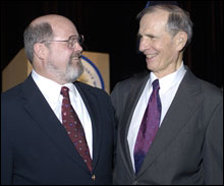Ralph Paffenbarger (1922-2007)
A Last Word on “Paff”
Paffenbarger, Jr., Ralph
There’s a credo of epidemiology, popular among the cardiovascular folks, that says: “If it isn’t fun, it isn’t epidemiology!” Ralph Paffenbarger, “Paff,” in his 60-year career, personified this idea of intellectual fun.
And he also lived by another admonition, that of the remarkable surgeon-epidemiologist who described a tumor of children in equatorial Africa, Denis Burkitt, who said, “What this world needs is more SIMPLE research!” “Paff” parlayed a simple questionnaire on exercise into a brilliant study, The Alumni Study, among huge numbers of intelligent, reliable responders, with guaranteed follow-up forever. Can you imagine your alumni association losing track of you? This allowed him and a small group of devoted colleagues to maintain a richly evolving theme and database for 50 years, still active today. What fun, and how smart can one get?
Fifty years of cordial relations (can you imagine an uncordial relation with “Paff?”) warmed in recent years when I got interested in history. Of course, “Paff” had always been interested and was a natural and curious historian, taking us back to antiquity and beyond, for example, “discovering” Ramazzini, the “first epidemiologist,” who compared sedentary tailors with active messengers.
Paff also tells the story of seeking Paul Dudley White’s advice about career directions in the early 1950s, when the noted dean of international cardiologists charged him to: “Go Forth, young man, and find out if the ancients were correct, as we suspect, that exercise is good for people!”
But “Paff” gave major credit for his career to a Public Health Service colleague, Jim Watt, with whom he worked on epidemic intelligence in the southwest. When Watt was made Director of the new National Heart Institute in 1952, cardiologists nationwide were aghast: “A diarrhea doctor in charge of heart research?!”
Watt immediately sent “Paff” to the Framingham Study and then supported his travels around the country organizing the Alumni Study. Also important to “Paff’s” flourishing career and that of many others of us, Watt established population studies and epidemiology as an administrative fixture in the extramural research program of the Heart Institute. There it remains today, even if we are #3. Can you imagine #1 and #2, the bench and clinical elite in NIH leadership, doing that 50 years ago without the diarrhea doctor in charge?
Historically, of “Paff’s” many friendships, the most enduring and endearing perhaps was that with another great pioneer of exercise epidemiology, Jeremy Morris. Jerry was greatly saddened by this loss. They used every international opportunity to meet and talked regularly by telephone.
Thanks to “Paff,” we know much more about the frequency, duration, intensity, and life course pattern of exercise that’s good for you. And thanks to “Paff,” we have had a positive, intellectually curious, and happy colleague in our work, one who had only one inexplicable, incomprehensible peculiarity: Ralph Paffenbarger could never find ill to say about any colleague! (Henry Blackburn, 2008)
